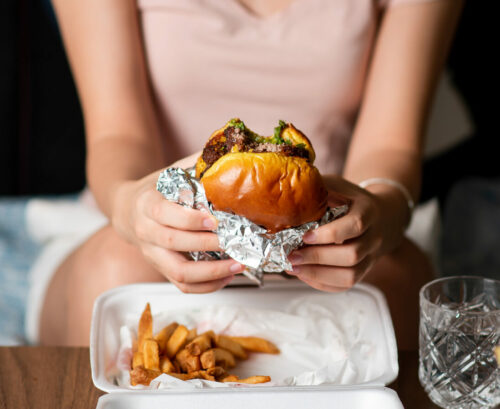
Eating alone affects what we eat. Some studies show that eating alone may lead to healthier diets, but many others show the converse. One large research review found that, broadly speaking, people living alone were less likely to follow healthy diets and tended to eat fewer fruits, vegetables and fish than those who lived with others.
Here are some of the common diet traps solo eaters can fall into – and how to avoid them…
Pitfall 1: ‘I often throw food away because it’s gone off before I can eat it’
Plan your meals for a week, then write a shopping list that includes only the ingredients you need in the quantities you need. Check labels when you’re buying and choose fresh foods with the longest use-by dates.
If products get close to their use-by date and you know you won’t eat them, freeze them – or cook them and freeze the results. For example, stew apples, make vegetable soup or whip up a tomato or cheese sauce. Once past their use-by date, however, they’ll need to be thrown away as they may be unsafe to eat.
Pitfall 2: ‘It’s expensive and hard to buy small portions or single-serve foods’
Chops, steaks, chicken breasts or thighs, bacon rashers, sausages, eggs and fish fillets are naturally individually portioned – so buy a family pack, remove what you want for the week, then wrap and freeze the remainder in single servings. Visiting meat, fish and deli counters means you’ll be able to buy exact amounts to suit you.
Look for bulk, refill or zero waste stores where you can buy single or smaller portions of ingredients like pasta, rice, oats, couscous, dried beans and lentils, dried fruit, nuts, seeds, flour, oils and vinegar.
Frozen veg, fruit, fish and chicken are often cheaper than fresh, and allow you to cook a single serving and leave the rest frozen. Large cans of food are more economical than small ones, so buy these and freeze half.
Finally, cut costs by reducing the variety of foods you buy. For example, instead of eight packs of different veggies, buy four bigger packs of versatile veg such as onions, peppers, tomatoes and mushrooms, which can be used to make a bolognese, traybake, soup, omelette and salad.
Pitfall 3: ‘I can’t be bothered to cook just for me’
Cook in bulk when you do prepare a meal and freeze whatever you don’t eat in individual portions. Choose dishes that require minimal preparation and clearing up – one-pot recipes such as casseroles, stews, traybakes, soups or omelettes are perfect – and make the most of time-saving ingredients such as prepped fresh vegetables, grated cheese and pre-cooked meat.
Pitfall 4: ‘I cook too much and end up wasting food’
Proper planning will help avoid this (see Pitfall 1) but get leftover savvy, too. If you don’t like eating the same thing two nights in a row, turn leftovers into a new meal.
You can transform leftover cauliflower cheese into a soup, use leftover mashed potato to make fishcakes or turn leftover veg into a frittata. Freeze leftovers like bolognese, chilli, soup, pasta, rice, mash or meat in individual portions for times when you can’t be bothered to cook.
Pitfall 5: ‘It’s easier to order a takeaway’
Keep your storecupboard and freezer filled with ingredients that can be turned into quick, simple meals in less time than it takes to get a takeaway delivered. Eggs, pasta, rice, noodles, canned fish, pulses, chopped tomatoes, soup, baked beans, low-fat cooking sauces, pesto and frozen veg are great choices.
Keep healthier takeaway-style ready meals in your freezer, too – Indian or Chinese food, pizza, breaded fish and oven chips from your freezer may not be the healthiest of options, but they’ll usually be lower in calories, fat and salt than the takeaway equivalent.
Pitfall 6: ‘It’s hard to find recipes for one’
Try our Meals for One recipes and see for yourself how cooking for one can be easy, delicious and healthy. Get cooking with some of our favourite recipe collections:
- 6 diabetes-friendly dinners for one recipes
- Speedy meat-free recipes for one
- 7 days of weight-loss dinners for one
While some recipes can easily be scaled down to a single serving, this is often a matter of trial and error and doesn’t work with every recipe. A safer bet is to make the recipe as it is, then freeze the remainder in individual portions.
For more advice on outsmarting eating traps, we recommend: How to beat classic diet traps or Top 10 everyday food traps and how to beat them.
www.healthyfood.com










